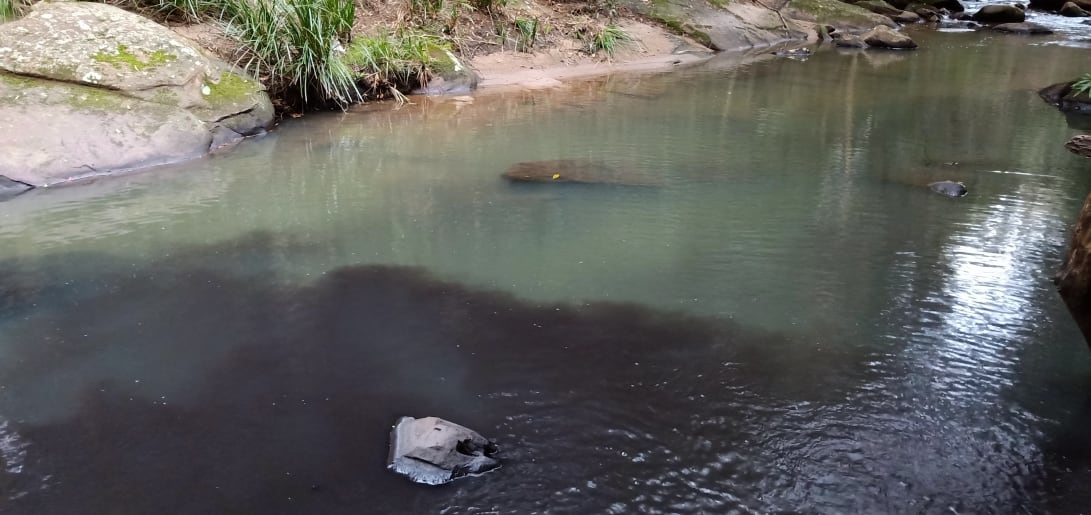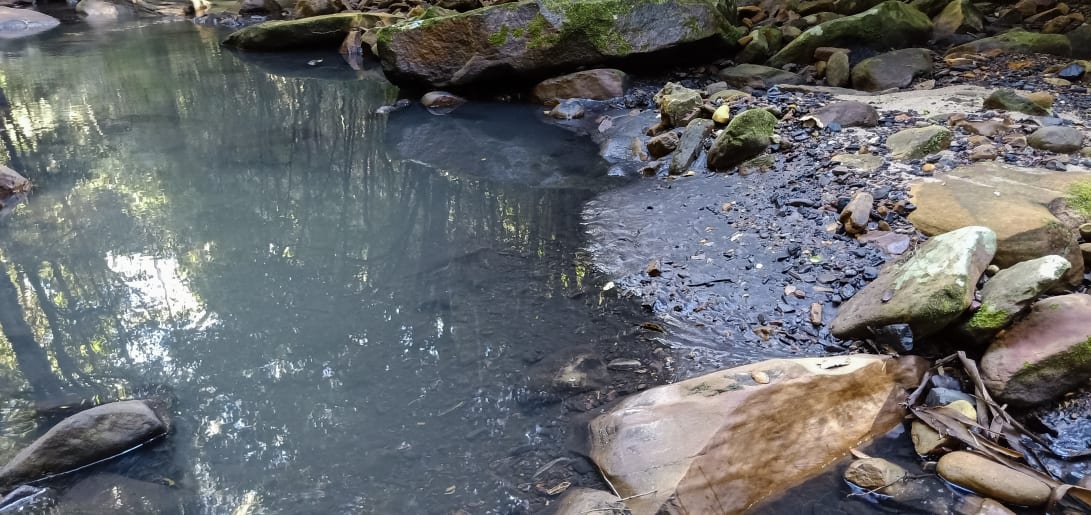In October 2022, the editor of Wild Magazine, Helensburgh resident James McCormack, shared a first-hand account of the pollution he discovered in an article in the Flame titled ‘Black filth’ found at Camp Gully Creek. Twelve months on, what has changed?

It’s been roughly a year now since I was making my way though one of the Royal National Park’s most beautiful sections – the lush rainforested valley surrounding Camp Gully Creek – and discovered the filthy black pollution and sludge that the nearby Metropolitan Mine in Helensburgh had discharged into the watershed. I immediately raised the alarm, alerting the NSW Environment Protection Authority (EPA), along with the then Environment Minister, James Griffin.
In the media scrum that followed, promises were made that the mine would be forced to clean up its act. Sadly, in the 12 months since, the improvements have been at best haphazard; at worst, they’ve been barely existent.
Since that September 2022 event, there have multiple other pollution incidents. (It should be noted there had been many incidents before that September event, too; the pattern is one of repeated poor behaviour).
One incident, in November last year, just months after the mine was ordered to clean up its act, resulted in the EPA issuing two fines totalling $30,000. This was an astonishingly paltry penalty. I‘ve done the sums – for a US-based multinational company like Peabody with 2022 revenue of US$5 billion, it’s the same as fining someone who makes $80,000 just 32 cents.
Not surprisingly, the fines did little to alter the mine’s behaviour and pollution events have continued into 2023.
In August 2023, there was another release of coal sediments onto Camp Gully Creek. As happened in September 2022, this has been attributed to heavy rain. But, as with last September, which was in the midst of dry spell, this doesn’t withstand scrutiny. The rainfall for this latest incident was just 80mm; it’s not nothing, but it’s hardly a downpour of phenomenal intensity. If the mine can’t withstand moderate downpours like this, then the beautiful environment downstream in the Royal and the Garawarra State Conservation Area is in real trouble.
Studies conducted after September 2022’s event showed that macroinvertebrates downstream were negatively impacted. Losses like these affect the entire food chain. This would always be of concern, but that’s especially so now given the reintroduction earlier this year of platypuses – having been apparently locally extinct for decades – to the waterways of the Royal National Park.
It's not all bad news, however.
As a result of September 2022's event, the EPA has varied the licence conditions under which the Metropolitan Mine operates, with real-time water quality monitoring being mandated (prior to this, monitoring was performed infrequently and haphazardly). And the mine itself has been more proactive in terms of notifying the EPA of breaches and in immediately undertaking cleanup action.
Naturally, such actions should be par for the course, but that has unfortunately not historically been the case. In September 2022, it took my chance discovery for the EPA to be notified. In the August 2023 event, as I understand it, the mine itself notified the EPA, and had workers engaging in cleaning up Camp Gully Creek and the Hacking River in days.
In September 2023, the EPA announced legal action against Metropolitan Collieries for discharges of coal contaminated water in September and October 2022. As part of the proceedings, the EPA asked me for an affidavit, which I readily supplied.
Let’s hope the fine, presuming one is levied, is meaningful this time. Five offences are being prosecuted; each could attract a fine of up to $1 million. And while a fine of $5 million would be a welcome start, it’s still pocket change for a multinational company like Peabody. Perhaps a penalty like a licence suspension would be more likely to make Peabody take notice.
There’s no arguing that the coal produced by the mine is used for steel production, something we all rely on. That, however, doesn’t give Peabody carte blanche to destroy our beautiful environment. If it can’t act responsibly, the debate over the mine’s right to operate at all is only likely to grow.
James shot the video above in August 2023.
NSW Environment Protection Authority release: 8 September 2023
The NSW Environment Protection Authority (EPA) is prosecuting Metropolitan Collieries Pty Ltd after two significant pollution incidents at Camp Gully Creek, which flows into the Hacking River in the Royal National Park.
The EPA alleges that Metropolitan Collieries failed to maintain surface water facilities at the mine site near Helensburgh which meant they were unable to cope with additional rainfall resulting in two discharges of coal contaminated water in September and October 2022.
Each of the five alleged offences under the Protection of the Environment Operations Act 1997 carries a maximum penalty for a corporation of $1,000,000. The matter is listed for directions in the NSW Land and Environment Court on 20 October 2023.
Read the full release here









